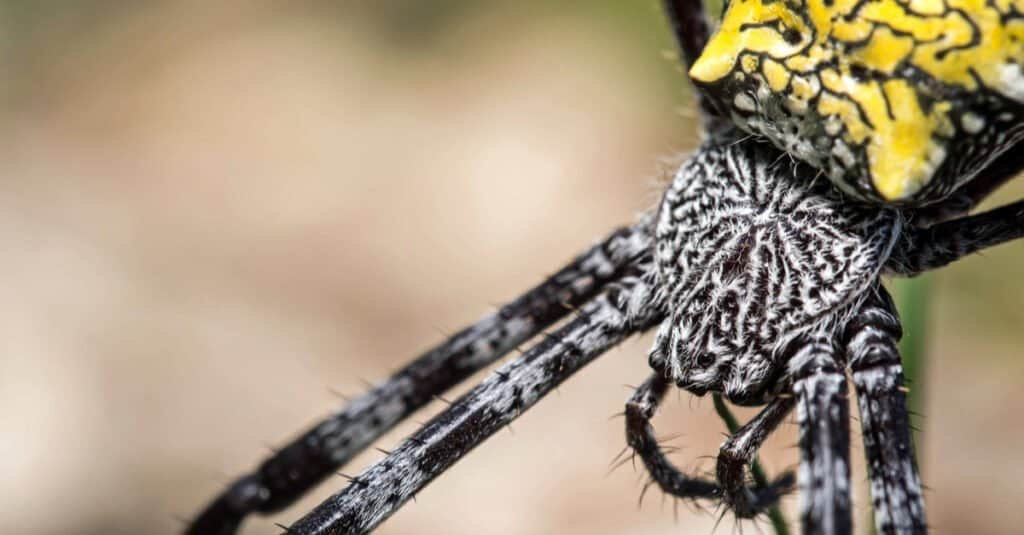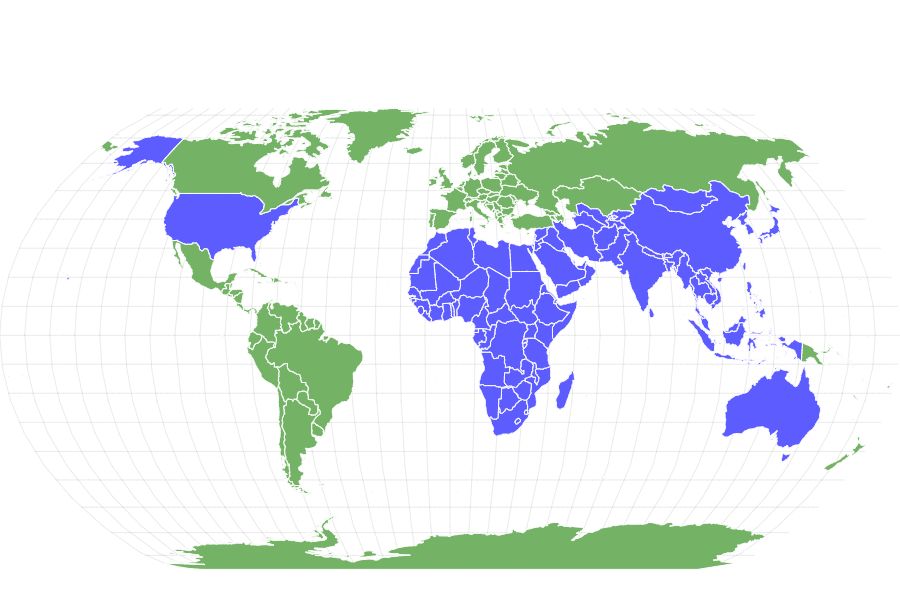Banana Spider
People spin clothing and fishing nets out of these spiders’ silk.
Advertisement
Banana Spider Scientific Classification
Read our Complete Guide to Classification of Animals.
Banana Spider Conservation Status
Banana Spider Facts
- Prey
- Mostly insects
- Name Of Young
- Spiderlings, hatchlings
- Group Behavior
- Solitary
- Fun Fact
- People spin clothing and fishing nets out of these spiders’ silk.
- Estimated Population Size
- Possibly millions. The IUCN classification of most Nephila species is least concern.
- Biggest Threat
- Climate change, habitat destruction
- Most Distinctive Feature
- The way their webs shimmer like gold in the sunlight
- Other Name(s)
- Giant wood spider, golden orb weaver, calico spider, writing spider, golden silk orb-weaver
- Gestation Period
- Three to four weeks, depending on the weather
- Litter Size
- 300 to 3000 hatchlings
- Habitat
- Moist forests, backyards
- Predators
- Birds, damselflies
- Diet
- Carnivore
- Type
- Arachnid
- Common Name
- Banana spider
- Number Of Species
- 12
- Location
- Warmer areas around the world
View all of the Banana Spider images!

“Weaver of the golden web ”
There are several genera of spiders called banana spiders, but few are as spectacular as Nephila. Not remotely as dangerous as the banana spider in “The Banana Boat Song,” these peaceable and relatively harmless arachnids spin webs that look like they are made of shimmering gold thread.
Moreover, the spider is notable for its extreme sexual dimorphism. This means that the sexes don’t look alike and don’t even look like they’re from the same species. This is mostly because the female is four times bigger than the male.
Though he must approach her with great caution to mate, tales of her eating him are exaggerated.
4 Incredible Banana Spider Facts!

Close-Up of Banana Spider
©Bildagentur Zoonar GmbH/Shutterstock.com
Read on for some fascinating facts about these spiders.
- Females of N. komaci are the world’s largest web-spinning spiders. A female can have a leg span of 4.7 inches with a body that’s 1.57 inches long, and her web can be more than 3 feet around.
- The dragline silk of banana spiders can be stronger than Kevlar, which is used to make bulletproof vests.
- Though Nephila spiders eat insects, they do not eat all kinds of insects. Some species will remove wasps and winged ants that get caught in their web because they are distasteful. Others seem to be terrified of perfectly catchable and edible cockroaches.
- Some of these spiders seem to be able to control how ultraviolet light reflects off their body stripes. This helps them attract prey, for the insects think the spider is a pollen and nectar-filled flower. The golden color of the web also attracts hapless pollinators.
Evolution and Origins
While there is not enough data and research to consider the evolutionary steps of the banana spider.
They feed on small- to medium-sized pests, such as mosquitoes, that can be a nuisance. Researchers have attempted to use the super-strong silk produced by golden orb weavers in a variety of ways, including as a fabric.
Numerous species of spiders are referred to as banana spiders, most frequently Trichonephila clavipes (formerly Nephila clavipes), also known as the golden silk orb-weaver. The term “banana spider” possibly refers to the creature’s characteristically yellow coloring and lengthy abdomen.
Although their bite can be painful, banana spiders are not deadly and are generally not seen as a serious threat to people. One species of banana spider, the Brazilian Wandering Spider, has the potential to occasionally produce severe symptoms.
Species, Types, and Scientific Names

Banana Spider Close-Up
©Yaping/Shutterstock.com
The name Nephila is Greek for “love of spinning,” which these spiders evidently have. There are at least 12 species, and some of these species have a number of subspecies.
- N. comorana
- N. constricta
- N. cornuta
- N. dirangensis
- N. komaci
- N. kuhlii
- N. laurinae
- N. pakistaniensis
- N. pilipes
- N. robusta
- N. tetragnathoides
- N. vitiana
- Nephila clavipes
- Nephila edulis
- Nephila komaci
- Nephila maculata
- Nephila pilipes
- Nephila senegalensis
- Nephila inaurata
- Nephila antipodiana
- Trichonephila inaurata
- Golden silk orb-weaver
- Nephila pilipes
- Trichonephila clavata
- Trichonephila edulis
- Nephila komaci
Appearance
The females of banana spiders are large for spiders, and they are much larger than their male counterparts, something that fascinates scientists.
A very large female can have a leg span that’s over 5 inches, and they grow even bigger around human habitation due to the availability of prey.
Males and females both have eight legs and slender bodies, though a gravid female’s abdomen is round like a gumball. The female can have an orange, greenish, or reddish body with lighter spots, with colorful stripes on her legs.
The legs sometimes have hairy tufts at the “joints.” Males are brown and are inconspicuous next to the gigantic female.

©iStock.com/NikonShutterman
Habitat
Golden orb weaver spiders prefer habitats that are warm and humid and have some leaf cover. Because banana spider webs are so large, they need sturdy structures to support them.
Therefore, you will find a banana spider web as well as the spider that wove it between buildings, between trees, or between trees and buildings. They are often found at the edges of woodland paths or clearings and near bodies of water or areas where water is available, such as garden hose spigots.
While the genus Nephila can be found across the world, banana spiders were introduced into the Southern United States. The first reports of banana spiders in the South were in 1862, since that time their range has spread from Florida to include Georgia and up into states like North Carolina, Tennessee, and Arkansas.
There is often a jumble of silk threads in front of the web that contains some debris, such as what’s left of the spider’s former prey. Some scientists believe this is to protect the main web from predators, blowing leaves, and other hazards. Others believe it is just what’s left of the spider’s old web.
Diet
Banana spiders usually eat insects. These include flies, moths, butterflies, dragonflies, grasshoppers, mosquitoes, bugs, and beetles. The spider wraps it in silk and sometimes caches it in a part of her web to be eaten in lean times.
View all 284 animals that start with BBanana Spider FAQs (Frequently Asked Questions)
Are banana spiders dangerous?
Banana spiders are not dangerous to human beings. Their bite is about as painful as a wasp sting. A truly dangerous spider also referred to as a banana spider is the Brazilian wandering spider of the Phoneutria genus.
How many legs does the banana spider have?
Like all spiders, the banana spider has eight legs.
How do you identify the banana spider?
The spider is best identified by the large size and colorful markings of the female and the bright golden color of her web in the sunlight. She’ll have a slender abdomen and colorful bands and tufts of hair on her legs. She may share her web with a few other, smaller spiders. These are mostly males of her own species, waiting to mate and sharing her food since males can’t weave their own webs after they’ve matured.
What is a banana spider?
In this case, a banana spider is a member of the Nephila genus.
How big can a banana spider get?
The body of a female banana spider can grow as long as 2 inches with a nearly 5-inch leg span.
What does a banana spider bite look like?
The area of the bite may be red and puffy for a time, but it subsides. An ice pack should be enough to treat its discomfort.
Is the banana spider poisonous?
Golden orb weaver spiders aren’t poisonous, but they’re venomous, as are all spiders. Venomous means they deliver a toxin to either subdue their prey or to defend themselves through their bite. A plant or animal that is poisonous is dangerous to eat, and the Raglai people of Vietnam cook and eat banana spiders with no bad effects.
What do banana spiders eat?
Banana spiders mostly eat insects that get caught in their web, but some are big enough to eat larger animals such as small snakes, lizards and mice.
Why do they call them banana spiders?
They’re called banana spiders because they’re sometimes found in shipments of bananas.
What are the differences between banana spider and garden spider?
The most significant differences between a banana spider and a garden spider include their size and coloration.
The banana spider is larger than a garden spider, possessing a body that can reach 2 inches long and a total legspan of 5 inches while possessing red, greenish-yellow, black, red, and white colors on its body. The garden spider measures about 1 inch long with a 3-inch legspan and have a black body with yellow markings and some brown on its legs near its body and joints.
What are the differences between banana spider and joro spider?
The greatest differences between a Joro spider and a banana spider include their genus and species, along with their locations throughout the world. The Joro spider’s scientific name is Trichonephila clavata, and it lives in Japan, Taiwan, Korea, China, and parts of the United States. The banana spider is from the Nephila genus and lives in Asia, Africa, Oceania, and North America.
What are the differences between an orb weaver and a banana spider?
The most significant differences between an orb weaver and a banana spider include their size, coloration, and habitat.
Thank you for reading! Have some feedback for us? Contact the AZ Animals editorial team.
Sources
- University of Vermont / Accessed September 19, 2021
- IUCN Red List / Accessed September 19, 2021
- Texas A&M University / Accessed September 19, 2021
- Healthline / Accessed September 19, 2021
- Integrated Taxonomic Information System / Accessed September 19, 2021
- Australian Journal of Zoology / Accessed September 19, 2021
- Nature / Accessed September 19, 2021
- Britannica / Accessed September 19, 2021


















